Malawi
Malawi is one of the least electrified countries in the world. Only 18% of Malawi’s 18.14 million inhabitants have access to electricity (11.4% provided by the grid network; 6.6% provided through off-grid energy solutions).
We explored some of the challenges and opportunities facing these projects, with an additional area of focus on the supply chains for off-grid energy equipment and links with resource flows, energy systems risk and resilience, and wider political economies of energy.
1. The first visit was to the Sitolo Solar PV Mini-Grid, started 2019 and implemented by Community Energy Malawi, directed by Edgar Bayani. This is an 80kw solar mini-grid, located east of Lilongwe in the Mchinje district, 7km from the Zambian border. The project enjoys financial support from the UNDP, the World Bank’s Global Environment Facility (GEF), and the Government of Malawi. The system currently connects some 660 customers with three maize mills, one of which is owned by the village chief of Sitolo, along with several other small-scale agro-processing facilities. These included a sunflower press, a peanut flour grinder, sugarcane distilling and livestock raising (chickens and pigs). One shopkeeper introduced us to her eldest daughter, who attends a boarding school near Lilongwe with income from various mini-grid-powered businesses (she is in Year 8). Community members in Sitolo and nearby villages frequently cross the border into Zambia to sell produce and other goods, with a high number of dual citizens in this area. The project has given attention to revenue raising, with a pre-paid meter system using tokens, but there is an awareness of constraints in the system’s capacity to support cooking among many households—the system will need to expand over time to support this. Concerning supply chains, Edgar explained that CEM obtains lots of the generation equipment from suppliers in South Africa and Zambia, with some of the transmission equipment supplied domestically. Malawi faces some structural disadvantages in accessing international supply chains; it is a landlocked country with an agro-export-oriented economy, with persistent foreign exchange scarcity and currency fluctuations, making equipment relatively expensive, along with extended delays for imports. For example, an inverter from South Africa took three months to arrive.

Sitolo village, Mchinji district, Malawi

Peanut flour grinder powered by the solar mini-grid, Sitolo village
2. We drove southeast from Lilongwe, and despite major delays setting off due to a petrol shortage affecting the country, we reached Dedza by nightfall. The next morning, we arrived at the Mthembanji Solar Mini-Grid project, situated near the town of Golomoti. An Irish development NGO, United Purpose, implemented the project from 2018-2023, with funding from the Scottish government through the University of Strathclyde. In March 2023, this mini-grid project will become independent and will need to raise its own revenue, running as a social enterprise, although still enjoying organizational and technical support from UP. The solar mini-grid provides lighting and basic services for community members, most of whom are customers for the project. We observed a range of village micro-enterprises and activities, including a young man who records and transfers audio, and a primary school teacher who accesses a multitude of learning resources through the internet on his mobile phone, which he can charge at home. This is one of two mini-grids implemented by United Purpose, with the second in Kudembe village (also in Dezda district). Regarding equipment for the mini-grid, UP has subcontracted with Sustain Power, a South African firm, including inverters and panels. Much of the distribution equipment, such as cables and poles, comes from Malawian suppliers. Smart meters and supporting software were installed and configured by Steamaco (a British company), allowing UP to closely monitor the system, according to project director Elizabeth Banda, with whom we spoke in Blantyre. A local contractor was hired to supply the new Kudembe mini-grid, which was commissioned in September 2020 but struggled to acquire some of the equipment needed.
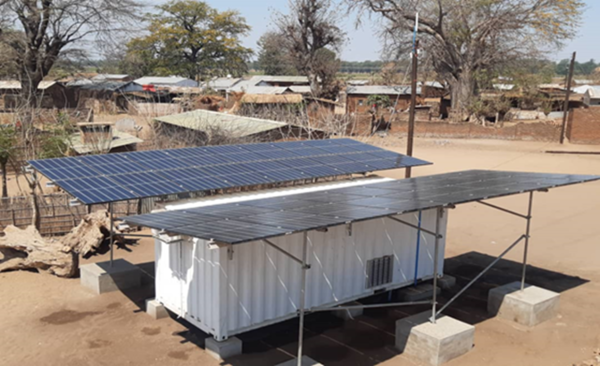
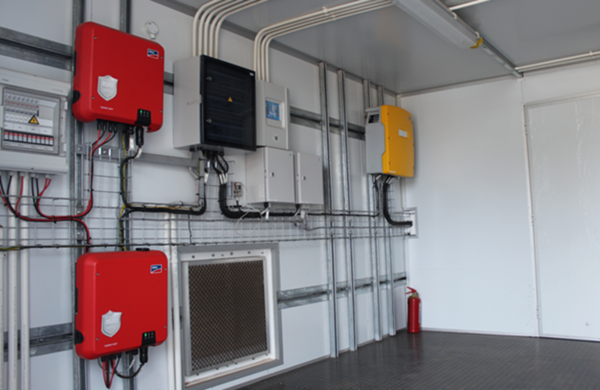
The solar grid
3. We set off next to Mulanje district, in southeast Malawi near the Mozambique border, to visit MEGA (Mulanje Electricity Generation Agency), one of Malawi’s first mini-hydro projects (another is in Chipopoma, near Livingstonia, in the northern region). Arriving in the area, Mulanje Mountain towers above the verdant, rugged landscape—with its granite outcrop and peak reaching an altitude of 3,002 meters—making it the highest mountain in south-central Africa. In Mulanje town, we met with MEGA project director, Arnold Kadziponye. The town is set amongst several tea estates, including Lujeri. The MEGA project consists of three mini hydropower plants constructed and operated by MEGA. We visited the Bondo 3 powerhouse, located near Bondo village, which supports a 220kw system with some 2,000 customers, powering 11 maize mills (most were previously diesel powered) and covering a radius of 22.6km. It also provides electricity to several primary schools, health clinics and shops. The Scottish government, the EU Commission, and the Global Environment Facility (GEF) provide financing for the project, which has been in operation since 2015. The mini-hydro system uses water from the Lichenya River, draining from the Mulanje mountain catchment. It diverts some of the water from the river, which is channelled alongside a valley before being dropped into the turbine via a penstock pipe.
The MEGA mini-hydro project was set up by Mulanje Renewable Energy Agency (MUREA) and Mulanje Mountain Conservation Trust (MMCT) with the international NGO Practical Action providing technical assistance and support with management. MEGA operates as a social enterprise with the aim to provide affordable electricity to nearby villages using micro-hydro power technology. According to Arnold, the business plan envisions that revenue from sales will cover the running costs, including staffing, operations, maintenance, VAT, site insurance and a small annual contribution to a community fund. MEGA’s business model aims to achieve economies of scale by developing multiple sites as there is considerable untapped potential for power generation along the Lichenya. A larger project is envisioned, with interest from a Kenyan electricity generation firm, Virunga Power.
We also learned about a MEGA pilot project to promote electric cookstoves, providing 20 households with hotplates, which has reduced pressure on local forests. Arnold explained that sourcing wall-mounted electricity meters for the Bondo mini-grid has been plagued by delays, despite the Malawi government holding a large number in stock, slowing new household connections to the system. Supply chains needed to speak to one another to make sure they were getting the equipment they needed and not equipment no longer in use. Very little of the equipment is local—the turbine is sourced from China, and the poles for the transmission lines are purchased in Zimbabwe. Technology components for systems maintenance are generally sourced from China, South Africa, Dubai, Germany, USA and India, with equipment shipped through the ports of Durban or Dar es Salaam. MEGA lacks a mobile money system for collecting revenue from users (or for customers to purchase credit), something they are looking into set up in the future. They are currently exploring options with domestic mobile providers. Many of the residents of Bondo and nearby villages produce tea for the large tea estates in Mulanje and Thyolo through outgrower schemes. Other crops grown in the area include pineapples, sugarcane, avocados and tomatoes.
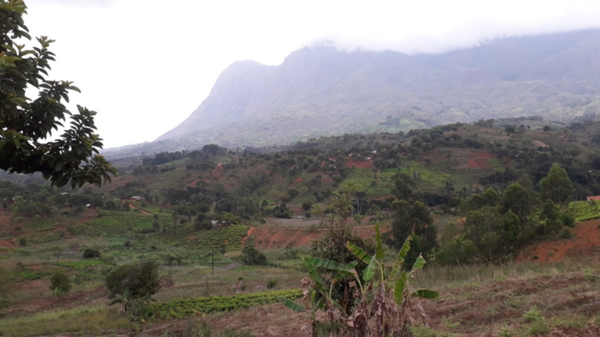
Mulanje Mountain
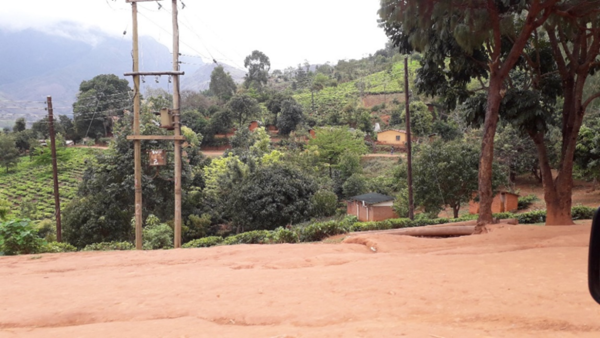
Mega Bondo mini-grid
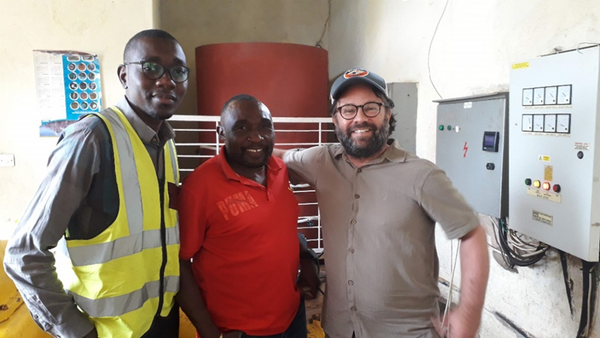
Chris Hara, Arnold Kadziponye, Josh Kirshner

MEGA Bondo 3 power station

Turbine equipment sourced from China
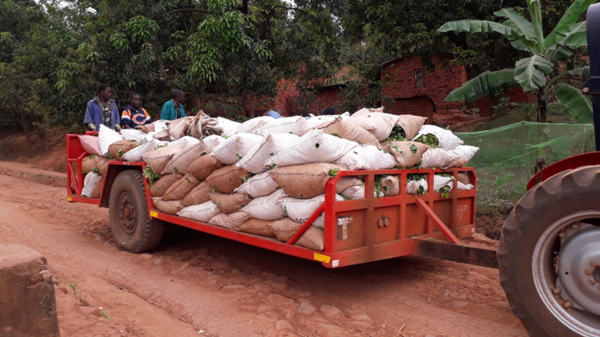
Tea producers near Bondo village, Mulanje
4. The Malawian NGO, Churches Action in Relief and Development (CARD), working with Practical Action, based in Harare, Zimbabwe, have implemented the Sustainable Energy for Rural Communities (SE4RC) programme in Nsanje and Chikwawa districts in Malawi’s far south. Since 2015, they have installed five solar mini-grids providing domestic energy and irrigation services—two in Chikwawa, two in Nsanje, and one in Gwande district, in Zimbabwe. We visited the Nyamvuu Solar Mini-Grid in Nsanje. The day before, we were able to speak with project director Melton Luhanga at the CARD office in Limbe, adjacent to Blantyre.
Nyamvuu is agricultural community with a 30kw solar system (with 120 solar panels) which is primarily used to power water pumps for irrigation. The region is low-lying, sits along the Shire River, and is prone to flooding, drought and other disasters (it was affected by Cyclone Idai, which struck neighbouring Mozambique with particular ferocity in early 2019). CARD, SNV and Practical Action (working as a consortium to support the project) have encouraged the community to grow a selection of high-value cash crops, such as sweet potatoes and onions while benefitting from the water pumps. In Nyamvuu, we spoke with Bingalason Longezo, who works with CARD (he is also a Gospel musician, based in Blantyre). Local residents can only access the electricity during the rainy season when the irrigation system is not needed. There have been some challenges and delays in sourcing equipment. Currently, for instance, the Nyamvuu mini-grid is not using the full 30kw capacity due to a recent pump failure. Strathclyde University, in Glasgow, UK, has been providing both the CARD and Sitolo mini-grid projects with technical support.
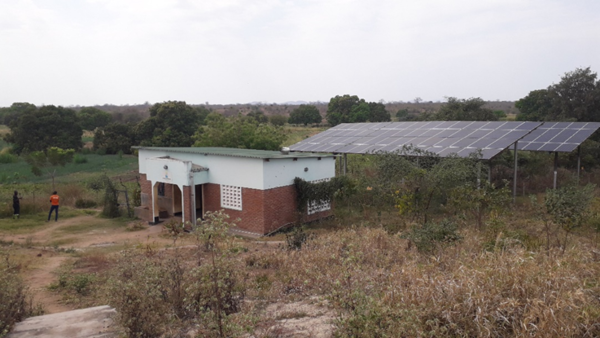
Nyamvuu mini-grid, Nsanje district
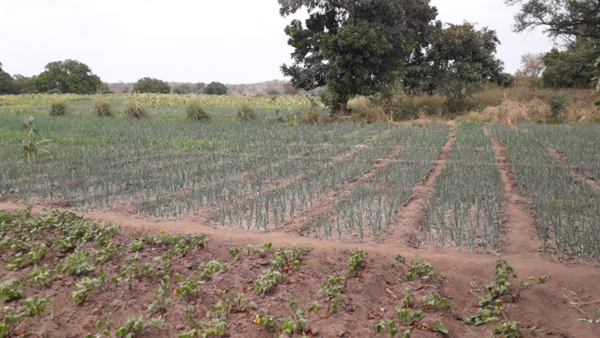
Crops on irrigated land in Nyamvuu
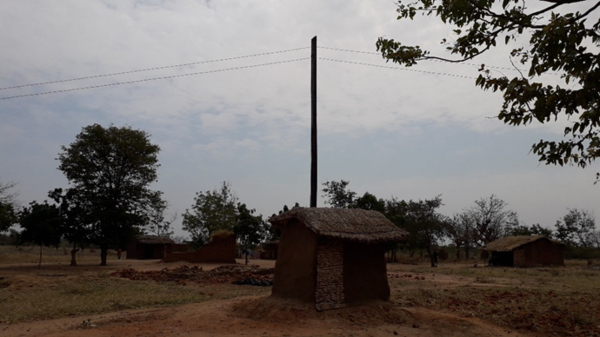
Nyamvuu mini-grid, seen from the village centre
All of this suggests that Malawi has nurtured a heterogeneous off-grid, community energy sector. There is considerable interest in extending these projects and scaling them up, both among CESET project partners, policymakers, members of the public and other actors in the sector. These projects depend on international supply chains for renewable energy equipment, maintenance and repair, and accessing these inputs and components continues to pose an important challenge. Networking and exchanging knowledge and ideas will be critical, along with developing sustainable local networks and considering how certain approaches can be transferred to other sites.